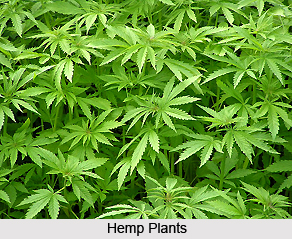The hemp plant was originally indigenous to Western and Central Asia. It has been domesticated since prehistoric times in Asia and Europe. The plant is believed to have arrived at China more than 4,500 years ago. It spread to the New World in post-Columbian times.
 Methods of usage
Methods of usage
Indian hemp cures a diversified form of diseases, mainly catering to excitation, intoxication and other types of drug-induced ailments.
Healing Power and Medicinal Properties of Indian hemp
Concoctions of Indian hemp have been in use as intoxicants in Asiatic countries and Africa since thousands of years back. Bhang, ganja and charas have been consistently used in these parts of the world. Western medical men appreciated its narcotic and anodyne properties in the early years of the bygone century and were integrated in the British and United States pharmacopoeias.
The leaves of the plant are used as a drug to lessen excitation, impatience and pain, as well as to hasten deep sleep. They are also used as a drug to counterbalance convulsive disorders, to increase the secretion and emission of urine and check any secretion or blood loss. As a sedative and anodyne, they are administered in dosages of 2.5 grams.
Three kinds of narcotics are produced from the hemp plant, viz. bhang or hashish, which make up the dried leaves and flowering shoots of male and female plants-has a low resin content. Ganja which is the dried unfertilised female blossoming of exceptional varieties grown in India and charas, which is the raw resin collected by rubbing the tops of the plant with the hands or beating them with a cloth. In all these drugs, the dynamic principle is a resin from the glandular hairs on its leaves, stems and inflorescences.
Diarrhoea and Dysentery cured by Indian hemp
The leaves are advantageous in the treatment of diarrhoea and dysentery. Two grams of dried leaves can be had with sugar and black pepper.
Insomnia cured by Indian hemp
The leaves help in lessening chronic sleeplessness. They can be dispensed to hasten sleep where opium cannot be used. Charas, which is the dynamic principle of hemp, as well as ganja, are efficient drugs to bring about deep sleep.
Digestive Disorders healed by Indian hemp
Bhang or hashish is regarded constructive in digestive perturbs like dyspepsia and other bowel complaints. It also acts as an appetiser when taken in minor dosages.
Nervous Disorders healed by Indian hemp
Charas is of immense value in periodic headaches, migraine, chronic mania, lunacy and delirium, nervous vomiting, nervous exhaustion, convulsions and neuralgia. It should be had in 1.5 to 6 centigram doses.
Gonorrhoea cured by Indian hemp
The seeds of Indian hemp are not narcotic. Their extract is positive in gonorrhoea. Bhang or hashish can also be consumed in this disorder.
Dandruff cured by Indian hemp
The juice of Indian hemp polishes off dandruff and head lice.
Skin Disorders healed by Indian hemp
A paste of the fresh leaves is effective in dissolving tumours. The pulverisation of the leaves functions as a useful dressing for injuries and sores. Ganja is externally administered to alleviate pain in prickly skin diseases.
Precautions - Too much consumption of hemp is injurious both physically and mentally. If had for a long period, it causes loss of appetite and gastric imbalance. Hemp drugs operate essentially on the cerebrum, where they correspond to the action of alcohol or opium.
Other Uses of Indian hemp
Poisoning - The smoke from flaming ganja is inhaled as an answer to poisoning by orpiment, an arsenic mineral used as yellow dye and artist`s pigment.
As a narcotic, hemp is consumed by itself or as a beverage. It is oftener used for smoking for ecstatic purposes. Unreasonable smoking is harmful and may drive one to lunacy. Hemp seed is used for manufacturing a drying oil and the fibre is used in making ropes.
Composition
Indian Hemp is a full-bodied, tall, upright, yearly herb, 1 to 5 metres in height, generally with male and female plants in approximately equal numbers. It has angular stems bearing palm-shaped or hand-shaped divided leaves with greenish flowers. The hemp plant provides three produces, viz., fibre from the stems, oil from the seeds and narcotic from the leaves and flowers.
In India cultivation of this plant is mastered and allowed only in the districts of Almora, Garhwal and Nainital (excluding the Terai and Bhabar) in Uttar Pradesh. To a small extent it is also cultivated in Kashmir, Travancore and Nepal.
The chief constituents of Indian hemp are cannabinol, pseudocannabinol and cannabinin. It also contains cannin, a resin. The biological activity of cannabis is due to alcoholic and phenolic compounds. The resin contains a crystalline compound, cannin.











